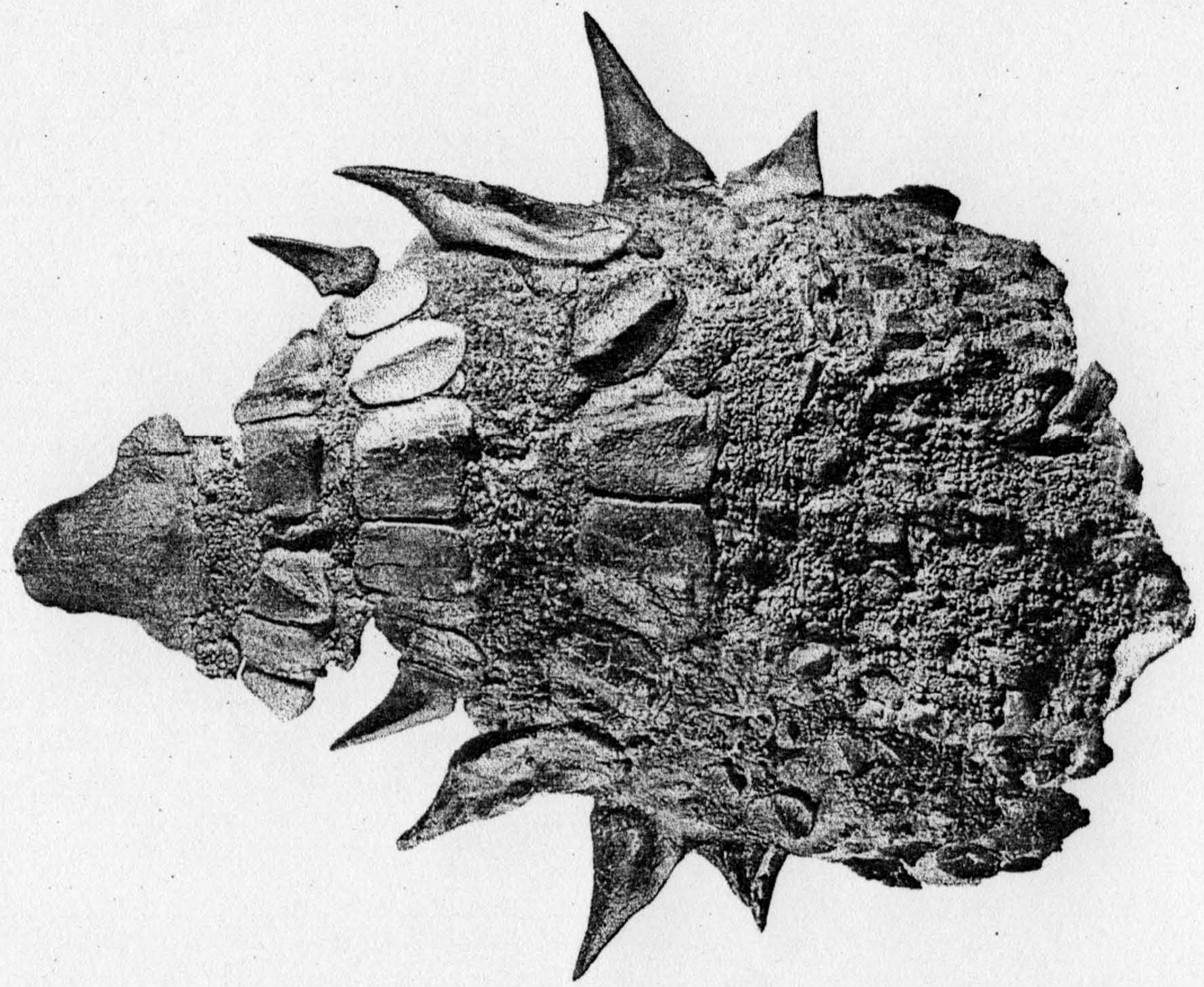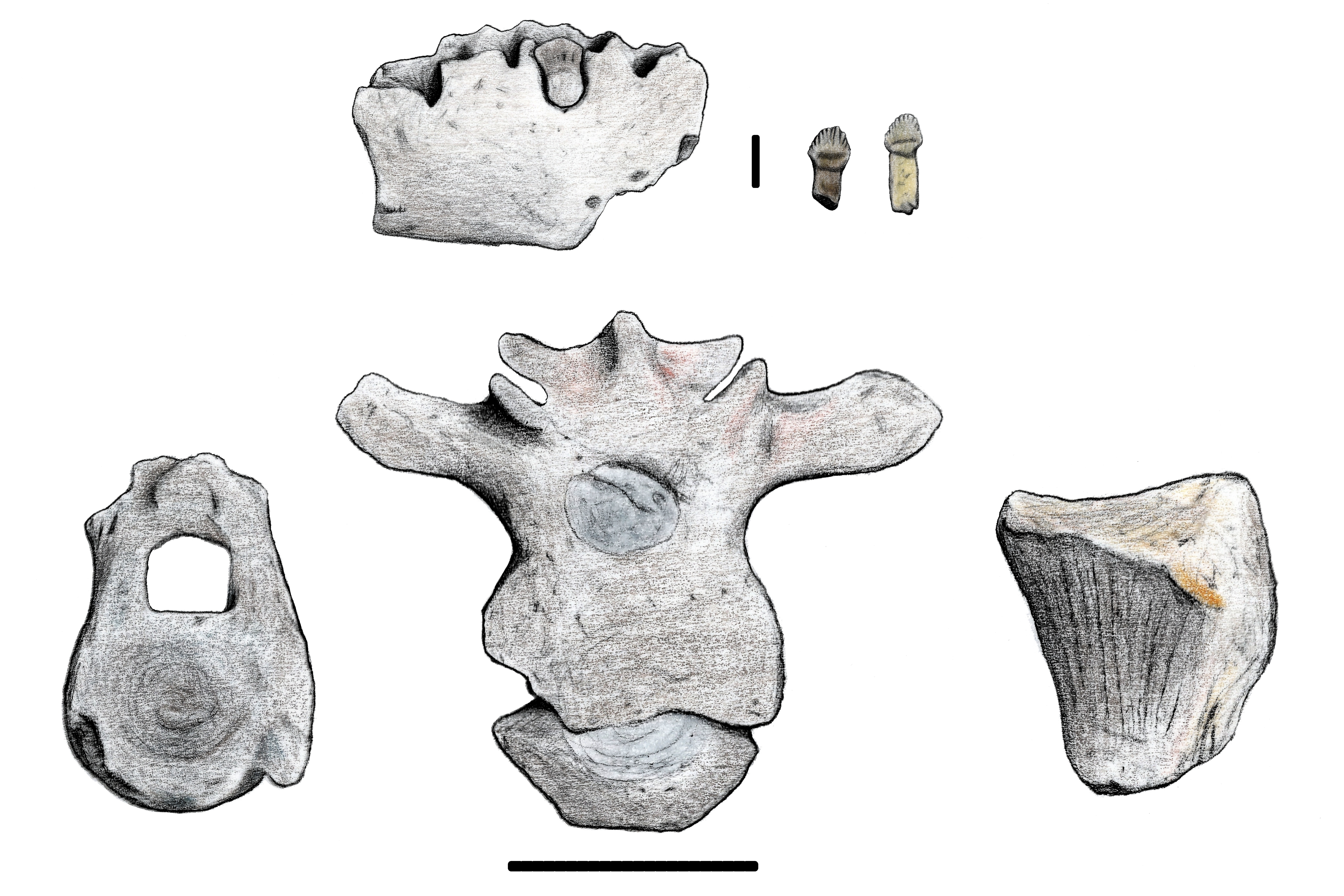|
Euankylosauria
Ankylosauria is a group of herbivorous dinosaurs of the order Ornithischia. It includes the great majority of dinosaurs with armor in the form of bony osteoderms, similar to turtles. Ankylosaurs were bulky quadrupeds, with short, powerful limbs. They are known to have first appeared in the Middle Jurassic, and persisted until the end of the Cretaceous Period. The two main families of Ankylosaurs, Nodosauridae and Ankylosauridae are primarily known from the Northern Hemisphere, but the more basal Parankylosauria are known from southern Gondwana during the Cretaceous. Ankylosauria was first named by Henry Fairfield Osborn in 1923.Osborn, H. F. (1923). "Two Lower Cretaceous dinosaurs of Mongolia." ''American Museum Novitates'', 95: 1–1/ref> In the Linnaean classification system, the group is usually considered either a suborder or an infraorder. It is contained within the group Thyreophora, which also includes the stegosaurs, armored dinosaurs known for their combination of pla ... [...More Info...] [...Related Items...] OR: [Wikipedia] [Google] [Baidu] |
Mymoorapelta
''Mymoorapelta'' (Meaning "Vannetta Moore and Pete and Marilyn Mygatt's shield" after a combination of the names of the discoverers of the Mygatt-Moore Quarry that fossils were originally collected from, and pɛltə "shield") is a monospecific genus of nodosaurid ankylosaur, a group of heavily armored, herbivorous, quadrupedal dinosaurs, from the Late Jurassic ( Kimmeridgian-Tithonian, around 155 to 150 million years ago) Morrison Formation (Brushy Basin Member) of western Colorado and central Utah, USA. Few specimens are known, but the most complete one is the holotype individual from the Mygatt-Moore Quarry that includes many osteoderms, a partial skull, vertebrae, and other bones. It was initially described by James Kirkland and Kenneth Carpenter in 1994. Along with '' Gargoyleosaurus'', it is one of the earliest known nodosaurids. ''Mymoorapleta'' is one of the smaller known nodosaurids, with the estimated length of the largest specimen only reaching . It had a n ... [...More Info...] [...Related Items...] OR: [Wikipedia] [Google] [Baidu] |
Parankylosauria
Parankylosauria is a group of basal ankylosaurian dinosaurs known from the Cretaceous of South America, Antarctica, and Australia. It is thought the group split from other ankylosaurs during the mid-Jurassic period, despite this being unpreserved in the fossil record. History of research During the Mesozoic era, the southern continents (South America, Antarctica, Australia, and Africa in addition to India and Zealandia) were unified into a supercontinent known as Gondwana. This was in contrast to the supercontinent of Laurasia in the Northern Hemisphere, with both originating from the breakup of Pangaea. Gondwana itself gradually split apart over the course of the Jurassic and Cretaceous eras. Ankylosaurian dinosaurs from Laurasia have historically been far more extensively recorded and studied. Reports of the group in Gondwana date back to 1904, with a specimen from Australia and include referrals of '' Loricosaurus'', '' Lametasaurus'', and ''Brachypodosaurus'' to group among ... [...More Info...] [...Related Items...] OR: [Wikipedia] [Google] [Baidu] |
Gargoyleosaurus
''Gargoyleosaurus'' (meaning "gargoyle lizard") is one of the earliest ankylosaurs known from reasonably complete fossil remains. The holotype was discovered in 1995 at the Bone Cabin Quarry West locality, in Albany County, Wyoming in exposures of the Upper Jurassic (Kimmeridgian to Tithonian stages) Morrison Formation. The type species, ''G. parkpinorum'' (originally ''G. parkpini'') was described by Ken Carpenter ''et al.'' in 1998. A mounted skeletal reconstruction of ''Gargoyleosaurus parkpinorum'' can be seen at the Denver Museum of Nature and Science and, alongside a couple skeletons of baby ''Stegosaurus'', has been on display there since around 2002. ''Gargoyleosaurus'' was present in stratigraphic zone 2 of the Morrison Formation.Foster, J. (2007). "Appendix." ''Jurassic West: The Dinosaurs of the Morrison Formation and Their World''. Indiana University Press. pp. 327–329. Discovery The holotype specimen of ''Gargoyleosaurus parkpinorum'' was collected by Western P ... [...More Info...] [...Related Items...] OR: [Wikipedia] [Google] [Baidu] |
Middle Jurassic
The Middle Jurassic is the second epoch of the Jurassic Period. It lasted from about 174.1 to 163.5 million years ago. Fossils of land-dwelling animals, such as dinosaurs, from the Middle Jurassic are relatively rare, but geological formations containing land animal fossils include the Forest Marble Formation in England, the Kilmaluag Formation in Scotland,British Geological Survey. 2011Stratigraphic framework for the Middle Jurassic strata of Great Britain and the adjoining continental shelf: research report RR/11/06 British Geological Survey, Keyworth, Nottingham. the Daohugou Beds in China, the Itat Formation in Russia, and the Isalo III Formation of western Madagascar. Paleogeography During the Middle Jurassic Epoch, Pangaea began to separate into Laurasia and Gondwana, and the Atlantic Ocean formed. Eastern Laurasia was tectonically active as the Cimmerian plate continued to collide with Laurasia's southern coast, completely closing the Paleo-Tethys Ocean. A subd ... [...More Info...] [...Related Items...] OR: [Wikipedia] [Google] [Baidu] |
Dracopelta
''Dracopelta'' (meaning “ dragon shield”) is a monospecific genus of ankylosaur dinosaur from Portugal that lived during the Late Jurassic (uppermost lower Tithonian-upper Tithonian, 152.1-145.0 Ma) in what is now the Lourinhã Formation. The type and only species is ''Dracopelta zbyszewskii'', which is represented by a partial skeleton including unpublished material. Discovery and naming In 1963 or, more likely, early 1964, a partial skeleton was discovered during road construction works between the village of Barril and Praia da Assenta. Leonel Trindade confirmed the presence of the fossil in the area and photographed the specimen ''in situ''. Georges Zbyszewski and Octávio da Veiga Ferreir organized the excavation and extraction of the specimen in December 1964. Parts of the specimen were unprepared and misplaced, mixed in with a specimen of '' Miragaia''. The holotype specimen, MG 3 (formerly IGM 5787 and IGM 3), consists of dorsal vertebrae, articulated proximal ribs, ... [...More Info...] [...Related Items...] OR: [Wikipedia] [Google] [Baidu] |
Armour (zoology)
Armour or armor in animals is external or superficial protection against attack by predators, formed as part of the body (rather than the behavioural use of protective external objects), usually through the hardening of body tissues, outgrowths or secretions. It has therefore mostly developed in 'prey' species. Composition Armoured structures are usually composed of hardened mineral deposits, chitin, bone, or keratin. Species with armour Armour is evident in numerous animal species from both current and prehistoric times. Dinosaurs such as '' Ankylosaurus'', as well as other Thyreophora (armoured dinosaurs such as Ankylosauria and Stegosauria), grew thick plate-like armour on their bodies as well as offensive armour appendages such as the thagomizer or a club. The armour took many forms, including osteoderms, spikes, horns, and plates. Other dinosaurs such as ceratopsian dinosaurs as well as some sauropods such as '' Saltasaurus'', grew armour to defend themselves, although a ... [...More Info...] [...Related Items...] OR: [Wikipedia] [Google] [Baidu] |
Ornithischia
Ornithischia () is an extinct order of mainly herbivorous dinosaurs characterized by a pelvic structure superficially similar to that of birds. The name ''Ornithischia'', or "bird-hipped", reflects this similarity and is derived from the Greek stem ' (), meaning "of a bird", and ' (), plural ', meaning "hip joint". However, birds are only distantly related to this group as birds are theropod dinosaurs. Ornithischians with well known anatomical adaptations include the ceratopsians or "horn-faced" dinosaurs (e.g. '' Triceratops''), the pachycephalosaurs or "thick-headed" dinosaurs, the armored dinosaurs ( Thyreophora) such as stegosaurs and ankylosaurs, and the ornithopods. There is strong evidence that certain groups of ornithischians lived in herds, often segregated by age group, with juveniles forming their own flocks separate from adults. Some were at least partially covered in filamentous (hair- or feather- like) pelts, and there is much debate over whether these filamen ... [...More Info...] [...Related Items...] OR: [Wikipedia] [Google] [Baidu] |
Dinosaur
Dinosaurs are a diverse group of reptiles of the clade Dinosauria. They first appeared during the Triassic period, between 243 and 233.23 million years ago (mya), although the exact origin and timing of the evolution of dinosaurs is the subject of active research. They became the dominant terrestrial vertebrates after the Triassic–Jurassic extinction event 201.3 mya; their dominance continued throughout the Jurassic and Cretaceous periods. The fossil record shows that birds are feathered dinosaurs, having evolved from earlier theropods during the Late Jurassic epoch, and are the only dinosaur lineage known to have survived the Cretaceous–Paleogene extinction event approximately 66 mya. Dinosaurs can therefore be divided into avian dinosaurs—birds—and the extinct non-avian dinosaurs, which are all dinosaurs other than birds. Dinosaurs are varied from taxonomic, morphological and ecological standpoints. Birds, at over 10,700 living species ... [...More Info...] [...Related Items...] OR: [Wikipedia] [Google] [Baidu] |
Herbivorous
A herbivore is an animal anatomically and physiologically adapted to eating plant material, for example foliage or marine algae, for the main component of its diet. As a result of their plant diet, herbivorous animals typically have mouthparts adapted to rasping or grinding. Horses and other herbivores have wide flat teeth that are adapted to grinding grass, tree bark, and other tough plant material. A large percentage of herbivores have mutualistic gut flora that help them digest plant matter, which is more difficult to digest than animal prey. This flora is made up of cellulose-digesting protozoans or bacteria. Etymology Herbivore is the anglicized form of a modern Latin coinage, ''herbivora'', cited in Charles Lyell's 1830 ''Principles of Geology''.J.A. Simpson and E.S.C. Weiner, eds. (2000) ''The Oxford English Dictionary'', vol. 8, p. 155. Richard Owen employed the anglicized term in an 1854 work on fossil teeth and skeletons. ''Herbivora'' is derived from Latin ''herba' ... [...More Info...] [...Related Items...] OR: [Wikipedia] [Google] [Baidu] |
2001 In Paleontology
Plants Pteridophyta Conifers Conifers are a group of cone-bearing seed plants, a subset of gymnosperms. Scientifically, they make up the division Pinophyta (), also known as Coniferophyta () or Coniferae. The division contains a single extant class, Pinopsida. All extan ... Angiosperms Arthropods Insects Fishes Newly named bony fishes Amphibians Newly named amphibians Ichthyosaurs Turtles Newly named turtles Lepidosauromorphs Newly named basal lepidosauromorphs Newly named plesiosaurs Newly named sphenodonts Archosauromorphs Newly named basal archosauromorphs Newly named crurotarsans Newly named dinosaurs Data courtesy of George Olshevsky's dinosaur genera list. Newly named birds Newly named pterosaurs Synapsids Non-mammalian Mammalian Footnotes Complete author list As science becomes more collaborative, papers with large numbers of authors are becoming more common. To prevent the deformation of the tables, these ... [...More Info...] [...Related Items...] OR: [Wikipedia] [Google] [Baidu] |
Tianchiasaurus
''Tianchisaurus'' (meaning "heavenly pool lizard"), also invalidly called ''Tianchiasaurus'' and "Jurassosaurus", is a genus of ankylosaurian dinosaur from the Late Jurassic ( Oxfordian– Kimmeridgian)-aged Toutunhe Formation of China. If it actually belongs to the family Ankylosauridae as proposed by Dong Zhiming, it would be the second earliest member of that family, being slightly younger than ''Spicomellus''. Unlike other ankylosaurids, it lacked a bony club at the tip of its tail. Discovery and naming The holotype (IVPP V. 10614), discovered in 1974, consists of skull fragments, five cervicals, six dorsals, seven sacrals, and three caudals, limb fragments, scutes and some unidentifiable fragments. The type specimen was informally referred to as "Jurassosaurus" after the 1993 film ''Jurassic Park'', and the species epithet ''nedegoapeferima'' is formed from the surnames of the film's main stars: Sam Neill, Laura Dern, Jeff Goldblum, Richard Attenborough, Bob Peck, ... [...More Info...] [...Related Items...] OR: [Wikipedia] [Google] [Baidu] |
Stegosaurides
''Stegosaurides'' (meaning "''Stegosaurus''-shaped") is a genus of herbivorous thyreophoran (perhaps ankylosaurid or possibly stegosaurian) dinosaur. It lived during the Cretaceous. Its fossils were found in the Xinminbao Group near Heishan in Gansu Province in China. These fossils consist of fragmentary material, including dermal spine elements. The genus is occasionally misspelled as "Stegosauroides". Discovery and species In 1930, Anders Birger Bohlin during the Swedish-Chinese expedition of Sven Hedin excavated fossils at Hui-Hui-Pu, between the Heishan en Ku’an-t’ai-shan mountain ranges, near Xinminbao, in the west of Gansu. These included two vertebrae of about eleven centimetres in length and a dermal spine base.B. Bohlin, (1953), ''Fossil reptiles from Mongolia and Kansu. Reports from the Scientific Expedition to the North-western Provinces of China under Leadership of Dr. Sven Hedin. VI. Vertebrate Palaeontology 6.'' The Sino-Swedish Expedition Publications 37, 1 ... [...More Info...] [...Related Items...] OR: [Wikipedia] [Google] [Baidu] |








_grazing_-_20050809.jpg)
